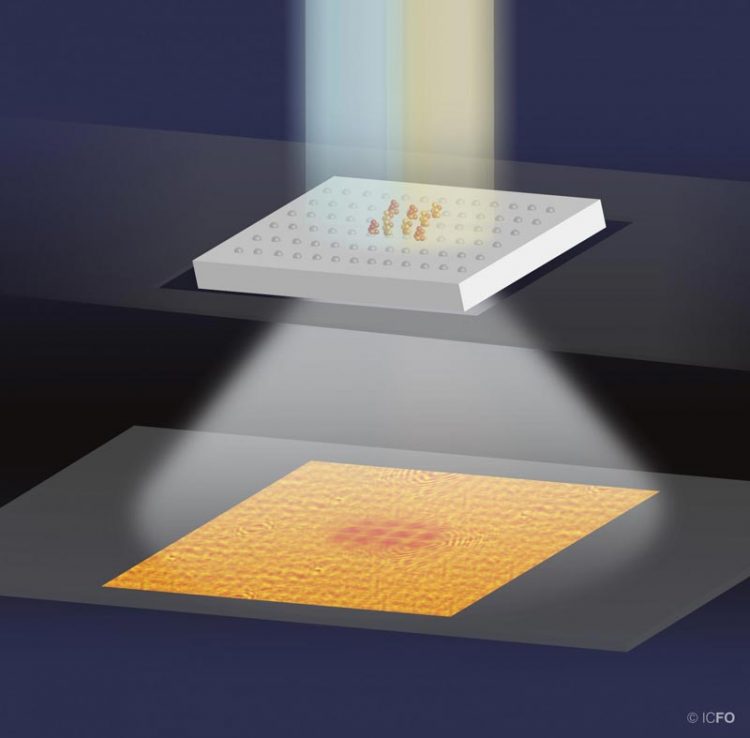A light microscope made only with consumer electronic products

A large field of view interferometric microscope can detect single protein layers. Credit: ICFO
Holographic, phase contrast or differential interference contrast (DIC) miscroscopes have been implemented especially for making “visible”, otherwise “invisible”, transparent objects, opening a new pathway towards the study and characterization of relevant structures such as biological cells or protein layers. The DIC microscope invented by Carl Zeiss several decades ago is one of the most popular in this field.
Now, even though these techniques have offered high sensitivity and resolution, they have shown to be severely limited as far as field-of-view (FOV) and depth-of-field (DOF), a major drawback and great limitation when it comes to large samples, where a scanning method is mandatory and time consuming. The trade-off will always be there: when trying to improve one parameter with a specific combination of lenses, the other will deteriorate.
Therefore, in recent years, research has been focused on developing microscopes without optical lenses or objectives that could offer unprecedented FOV while maintaining fair sensitivity and resolution.
In a paper published in Science Advances, ICFO researchers Roland Terborg, Josselin Pello, Ilaria Mannelli, UPC Prof. at ICFO Juan P. Torres and ICREA Prof. at ICFO Valerio Pruneri, have built a novel low-cost, compact on-chip microscope, made with consumer electronic products, capable of simultaneously measuring nanometer-thick changes over a large volume (0.5cm^3) in transparent objects such as glass.
The researchers have developed a large FOV interferometric on-chip lens free microscope (LIM) based on a novel design with a very high axial sensitivity and DOF, applying a technique adequate to be used in microarray platforms for the detection of proteins without the need of labels.
As Roland Terborg comments, “The challenge of developing a lens-free microscope to detect single protein layers (less than 1nm of optical path difference) seemed rather difficult at the beginning. But as we started to develop the device, everything seemed to fit in very well surpassing our expectations! Instead of having to use very expensive components, we discovered that we could actually use consumer end products without a significant decrease in its sensitivity”.
By using collimated polarized light, the team of scientists was able to reconstruct the image by shining light through the transparent sample to observe and analyze the phase shift and interference intensity pattern, a technique known as phase-shifting interferometry (PSI). As UPC Prof at ICFO Juan P. Torres states, “any slight refractive index change introduced by an impurity in the sample is translated into a phase difference and thus an intensity variation in the pattern, showing the contours and therefore size of the irregularity”.
As ICREA Prof. at ICFO Valerio Pruneri comments “the device means a major step forward for light microscopy techniques, especially for microarray platforms since it could definitely be used as a point-of-care tool in the diagnosis and treatment of major diseases such as Sepsis, a critical area where fast and accurate results can translate into life changing health outcomes for individuals. We are also thrilled by the fact that this will be part of the Sixsenso spin-off project portfolio including similar devices for detection of particulates and micro-organisms”.
The new device has proven to be low-cost, compact, and extremely suitable for point-of-care applications, making it an ideal device to be fully integrated in cameras of smart phones or tablets and used for detecting and scanning of transparent objects or surfaces.
###
Reference
“Ultrasensitive interferometric on-chip microscopy of transparent objects” R. A. Terborg, J. Pello, I. Mannelli, J. P. Torres, V. Pruneri, Sci. Adv., Science Advances, 2016, Vol. 2, no. 6, e1600077, DOI: 10.1126/sciadv.1600077
Media Contact
All latest news from the category: Materials Sciences
Materials management deals with the research, development, manufacturing and processing of raw and industrial materials. Key aspects here are biological and medical issues, which play an increasingly important role in this field.
innovations-report offers in-depth articles related to the development and application of materials and the structure and properties of new materials.
Newest articles

Innovative vortex beam technology
…unleashes ultra-secure, high-capacity data transmission. Scientists have developed a breakthrough optical technology that could dramatically enhance the capacity and security of data transmission (Fig. 1). By utilizing a new type…

Tiny dancers: Scientists synchronise bacterial motion
Researchers at TU Delft have discovered that E. coli bacteria can synchronise their movements, creating order in seemingly random biological systems. By trapping individual bacteria in micro-engineered circular cavities and…

Primary investigation on ram-rotor detonation engine
Detonation is a supersonic combustion wave, characterized by a shock wave driven by the energy release from closely coupled chemical reactions. It is a typical form of pressure gain combustion,…



